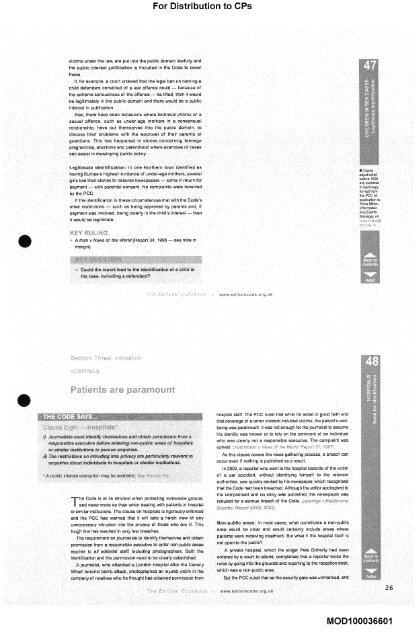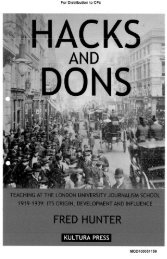The Edi ' - The Leveson Inquiry
The Edi ' - The Leveson Inquiry
The Edi ' - The Leveson Inquiry
You also want an ePaper? Increase the reach of your titles
YUMPU automatically turns print PDFs into web optimized ePapers that Google loves.
For Distribution to CPs<br />
victims under the law, are put into the public domain lawful yand<br />
the public interest justification is included in the Code to cover<br />
these<br />
If. for example, a court ordered that the legal ban on naming a<br />
child defendant convicted of a sex offence could -- because of<br />
the extreme seriousness of the offence -- be lifted, then It wouid<br />
be legitimately in the public domain and there would be a euolic<br />
interest in 3ublicetion<br />
Also, there nave been occasions where technical victims of a<br />
sexual offence, such as uneer-age mothers in a consensual<br />
relationship, have put themselves into the public eomam, to<br />
discuss their problems with the approval of their parents or<br />
guardians. This t~as happened in stories concerning teenage<br />
~regnancies, abortions and parenthood where exameles of cases<br />
can assist in developing public policy<br />
Legitimate identification: in one Northern town identified as<br />
having Europe’s highest incidence of under-age mothers, several<br />
girls told their stories to national newspapers -- some in return for<br />
payment -- with earental consent. No comelainta were received<br />
by the PCC.<br />
if the identification ,q these circumstances mat with the Code’s<br />
other restrictions -- such as being approved by parents and, if<br />
payment was involved, being clearly in the child’s interest- then<br />
it would be legitimate.<br />
A man v News of the World (Resort 34, 1996 -- see note in<br />
margin),<br />
COuld the report lead to the identification of a child it,<br />
the case, including a ~efendant?<br />
L<br />
he Code ~s at its strictest when protecting vulnerable groups,<br />
Tand never more so than when dealing with patients in hospital<br />
or similar institutions. <strong>The</strong> clause on hospitals is rigorously enforced<br />
and the PCC has warned that it will take a harsh view of any<br />
unnecessary intrusion into the privacy of those who are ill. This<br />
tough line has resulted m very few breaches,<br />
<strong>The</strong> requ rement onjournallsts to identify themselves and obtain<br />
permission from a responsible executive to enter non-public areas<br />
applies to a// editorial ata~ including 3hotographers. Both the<br />
hospital staff. <strong>The</strong> PCC ruled that while he acted in good faith and<br />
that coverage of a terror incident included victims, the satlent’s wellbeing<br />
was paramount. It was not enough for the journalist to assume<br />
hie identity was known or to rely on the comment of an individual<br />
who was ctearly not a responsible executive. <strong>The</strong> complaint was<br />
As this clause covers the news-gathering process, a breach can<br />
occur even if nothing is published as a result<br />
In 2002, a reporter who went to the hospital bedside of the victim<br />
of a car accident, without identi’-yqng himself to the relevant<br />
authorities, was quickly sacked by his newspaper, which recognised<br />
that the Code had been breached. Although the editor apotogised to<br />
the complainant and no story was publ~sheCi, the newsuauer was<br />
rebuked for a serious breach of the Code. J,~,tff~p, gs vEas~{;u~,~h~J<br />
Nan-public areas: In most cases, what constitutes a non-public<br />
area would be clear ann would certainly include areas where<br />
pat ants were race v ng treatment But what if the hasp tel itself is<br />
not open to the public~<br />
identification and the permission need t( be Clear y establ shed<br />
A private hospital, which the singer Pete Doherty had been<br />
ordered by a court to attend, complained that a reporter broke the<br />
A journalist, who attended a Landor hasp ta after the Canary rues by go ag nto the grounds and report ng to the recept on desk<br />
Wharf terrorist bomb attack, photograpi =d an injured victim in the which was a non-public area,<br />
company of relatives who he thought ha~ obtained permission from Bat the PCC ruled that as the security gate was unmanned, and<br />
@ Cases<br />
adjudicated<br />
before 1996<br />
are available<br />
~n nard-copy<br />
format from<br />
the PCC on<br />
application to<br />
Tonia Milton<br />
Informa[~r<br />
and Events<br />
Manage£ o£<br />
26<br />
MAD100036601
















